Alan, Spring Satin is not a Dave Wilson variety, are you sure you remember correctly? Those Dave Wilson retailers either mostly or exclusively sell Dave Wilson varieties so I suspect what you have is not Spring Satin.
You are right, but the mistake isn’t the ID, just my assumption that it was a Zaiger creation and my hunch is was from a west coast supplier. I now realize I must have purchased my tree from ACN (which also gets a lot of their pluots from DW). Because all my earlier pluots were purchased from west coast Wilson distributors I assumed this one was as well. In more recent years, I’ve purchased pluots from ACN. Spring Satin is the only interspecific hybrid they carry not from DW and I never noticed.
There is zero doubt in my mind that this tree is correctly identified because its characteristics are so unique and distinctive and match the published descriptions of SS perfectly.
I should also say that SS turns dark purple while still hard (and sour), Methely most certainly doesn’t.
It’s funny that the only interspecific variety I’ve tasted that seems to actually be an interspecific variety based on taste profile didn’t come from the bragging Zaigers. They have aggressively marketed the virtue of their breeding success for years, and they have come up with some great J. plums, but nothing that I have found carries any of the characteristics of an apricot.
I mention this frequently in this forum- am I the only one who has this experience with Zaiger pluot creations? Am I missing something some of you are experiencing?
I agree with you that their pluots are excellent tasting plums, I don’t feel any apricot components in them.
By the way, my SS in my old property was from ACN and it indeed matched the published descriptions and experiences of other forum members.
Yeah I too don’t taste apricot but I could care less about that. The flavors are rich and complex which is great but what attracts me is how well they grow and produce. At least many of them do. Plums in general seem to be shy producers with some exceptions. Sensitive to late freezes too. The pluots have been much more reliable for me. Grafts of plums seem to take longer to fruit than grafts of pluots. I also grafted green wood to try and save a graft from a dying tree. The grafts of the pluots all took and the plums did not. I’m going to try again Thursday. I didn’t know green wood, growing wood, would take but they most certainly will. My grafting season just got extended. I guess it makes sense as often people bud graft this time of year. Nice to know it’s not limited to bud grafting.
SS is the only pluot, that I know of, that was specifically developed for Southern growers.
That is amazing. CA commercial growers complain about their lack of productivity compared to plums and many of them fall on the very early blooming side of J plums which bloom before E’s in the first place. Flavor Grenade is quite productive of fruit that tends to crack here and I’m optimistic about Dapple Dandy, but I have several variety of J. plums that are as or more reliable producers.
Many pluots are highly susceptible to bacterial spot and are not vigorous growers here (perhaps copper sprays would help).
Why do you suppose pluots are so much more productive for you? What plums have not worked there?
That is very interesting -
The grafts of the pluots all took and the plums did not. I’m going to try again Thursday. I didn’t know green wood, growing wood, would take but they most certainly will.
I have a SS that I planted this spring. And a Toka and Santa Rosa that have never held onto a plum long enough for it to develop. I think I’ll try grafting some of the new long growth from my SS - to both of them.
I don’t know? All gardening is local, others may see the exact opposite where only plums work. It is very strange. I just thinned 12 more I didn’t see so clustered. although they are close to ripe. Probably just wasted 12 fruit. At least 7 cultivars work well here. Lavina plum is the only plum I have that seems to produce a lot. All the pluots are close to one another. I did add others far away but too young to comment on.
I have Inca and Black Ice on a dying tree. The wood is still good, but the roots of the tree are dying from a flood in my yard 2 years ago. It took that long to kill this peach tree. I’m going to put in a 2 foot raised bed and plant another peach. I’m supporting the tree trying to keep fruit and scion alive. The roots and base of tree are compromised. If left on it’s own, it falls over. I’m going to graft right now on some rootstock I have. I had one pluot on it and that graft took, both of them. I did two. Leaves at every node now. OK running out of time I better graft right now. I’m not living here anymore, but at my cottage. I come in 2-3 times a week for a few hours. It’s not working well, but I have to keep the wife happy. I would rather stay here, but the wife loves the fresh air and beautiful river. I do have a garden there too. I put two Jujubes there, I’m very curious about this fruit. They are doing great 2nd leaf. I put a Shipova in too, and Oscar mulberry grafted on some Russian rootstock I bought from Burnt Ridge.
I also added hazelnuts there, they are doing great too, 2nd leaf. I put in 4 trees. Also 2 hickories shag and shellbark. Blueberries, blackberries, black currants and honeyberries there too Rhubarb onions and tomatoes in that garden also. Two tart cherry trees were on the property and gave a good yield this year. I prefer the bush cherries, but hey any cherry is cool.
In my limited experience with Toka, it hardly set any fruit after blooming profusely . It was one of 17 grafts on a Shiro plum. It appeared Toka did not likeany of as its pollination partner.
I recalle someone had a productive Toka tree. I cannot remember what pollinate it.
Toka is a cross of American Plum.My grafts haven’t set fruit,so I purchased some other varieties,with similar traits,like Kahinta and LaCrescent,to help pollinate.
For the hybrids I believe native American plums, or our native Canadian variety Prunus nigra are the best pollinators. I planted several small Prunus nigra this year but they have not flowered yet. I intend to eventually graft branches to other Japanese or hybrid trees to help with pollination.
Tippy my toka set a lot of fruits. The problem with toka is that its fruits are small. I believe Superior pollinates toka.
Brady,
That’s a good thought.
@IL847 -I removed multi- grafted plum tree and Toka went with it. No regret on Toka. Agree that it is small. The taste maybe a bit different but not enough to attract me.
So you haven’t tried growing common, good yielding and delicious plums like Satsuma or the ever reliable Shiro. Never tried the queen of J. plums- Elephant Heart, or Early Magic which I’m harvesting now and is very high quality. You’ve experimented with pluots and not really given many J. plums varieties a chance.
Have you tried growing any Euro plums at all? I think they are much better for culinary use than Pluots or J. plums, have higher brix and flower about a week later than the latest J. plums, so are less likely to be frozen out.
What 7 varieties of pluots have consistently produced fruit for you?
Honestly, I’ve eaten a lot more pluots from a store than off my trees. We get too much rain during to growing season for anything that cracks easily from a couple consecutive days of rain a week or two before harvest. I have a variety of E. plum called Autumn Sweet which is the only one of this species I know of that gets up very high brix while still crisp- but like Flavor Grenade it is a cracker.
I have had a few great Flavor King pluots form my own tree and the first year Flavor Grenade bore fruit it was amazing (not much bouquet but I love eating a sugar sweet crisp plum) but it was because of timely drought. I have a Flavor King graft that is loaded with fruit but my tree died from bacterial spot a couple of years ago. Most pluots do not flourish under summer rain, apparently.
I do have satsuma and it doesn’t make enough plums to thin. I have slowly converted tree over to other cultivars Toka, Superior which does set a decent amount of fruit. Elephant Heart has never set one fruit but flowered the last three years. Toka set three fruit this year.
I’m not home so cannot reference all the pluots I have. I can say all set a lot of fruit except Flavor Supreme and Flavor Queen. Flavor King sets the worst but still produces 30 to 40 fruits. Compared to Satsuma setting 10 fruits. Santa Rosa set one fruit. It’s not even a contest.
I don’t care for euro plums. Not my thing.
Dapple Dandy and Geo Pride set about 120 fruits I thinned to 50. Flavor Grenade set tons too. I can’t remember the names of the others? Oh Splash is another Fall Fiesta set about 80 as did another late pluot Flavor Finale. I’m starting to remember names. Flavor Gem is still being evaluated. Looks to be a winner. Looking for Flavor Blast. One with Emerald in the name easily set 100 fruit. Like I say plums are nowhere near these pluots I have at least six others that set well too. I can’t remember the names?
Plums that set ok for me are Superior, Lavinia, Inca, Hollywood, and black ice. I lost Hollywood looking to replace. I may lose Inca and Black Ice. I will replace them. I wish Vermont would set fruit. I really wanted to try that one. Same with Howard Miracle. Laroda set one fruit. Sucks!!! At least I get to try it.
Anyone try Rosemary? Looks interesting. My Nadia in its 4th year flowering finally set a decent amount of fruit. I like this plum. Tart but good.
Last I checked I had 25 plum or pluot cultivars. Plenty of both to cover all. Pluots win in a near shutout 10 to 1.
Elephant heart is a mystery but one thing about it is that it takes as long as an E. plum to come into bearing as grown on Myro in my experience and other’s I’ve heard from.
Here, I believe the difference between a plum bearing and not bearing is exclusively about the time it flowers, having a compatible variety nearby and if either the pollinators are present when they bloom or if the ovules are destroyed by frost. I cannot understand any mechanism regarding local conditions that would add to that and there are earlier and later flowering varieties of both J. plums and pluots.
I have never heard anyone else suggesting that pluots are generally easier to crop than J. plums and what I like to do is know what is actually happening. Unexplainable anecdotes don’t really help me understand what’s going on when they fall on a single person’s experience.
Hi Alan.
Well, I can speak with good criteria given that my collection of Japanese plums, and pluots is very extensive.
In my opinion there is no difference in the speed of entry into production of the Japanese plums to the pluots (we always speak in grafted varieties on Mirabolan 29-C, which is the rootstock that I use).
My varieties of this type go into production around 5-6 years.
But the period of formation pruning has a lot to do with it.
It must be borne in mind that the two varieties have a tremendous fondness for vertical growth, and to have productive trees with good structure, at least 4 or 5 years of very short pruning are needed during the vegetative period (such as the formation of cherry trees. ).
I do the following:
-
I decapitate the initial scion 50 centimeters from the ground.
-
Once the three or four primary branches have reached a length between 70-80 centimeters, and being in the vegetative period, I cut them to 15 centimeters (the first pruning is ultra-short).
-
From each primary branch cut two or three new branches will come out, which when they reach 70-80 centimeters again, I cut them to 20 centimeters (this second and successive pruning are carried out at 20 centimeters).
-
Third pruning the same as the previous one.
-
Fourth pruning the same if necessary (may not be necessary).
It must be taken into account that in all the previous pruning described, no central branch is eliminated, since these branches force the outer branches to open outwards
Now that it is the fourth or fifth year, the fruiting entry pruning is carried out, which unlike the previous ones is carried out in winter in a winter dormancy period, and its work is as follows:
-
Cleaning of all the branches inside the tree, so that there is good aeration, eliminate crossed branches.
-
Height pruning (this pruning induces fruiting), here there is no standard height, and everyone can leave the tree at the height they like, but the normal is a height of about 3 meters, so that all the works (harvesting, pruning, treatments) can be carried out without the need for ladders.
If this type of formation pruning is carried out (which is the ideal), a Japanese plum or a pluot grafted on mirabolan, it usually takes about 5 years to enter production (first fruits), with the years the harvests will increase in quantity.
Precisely Elephant Heart is a variety that I really like
Some photos of my Elephant Hearts
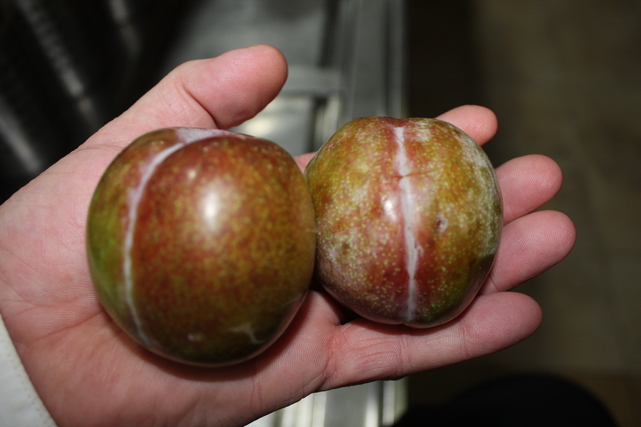
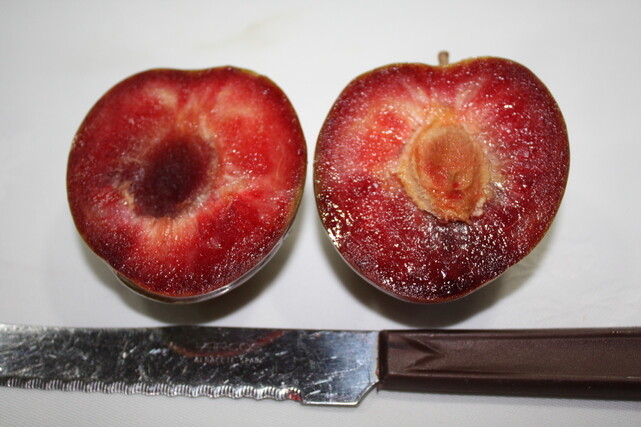
See a harvest of Marcia’s Flavor pluot variety
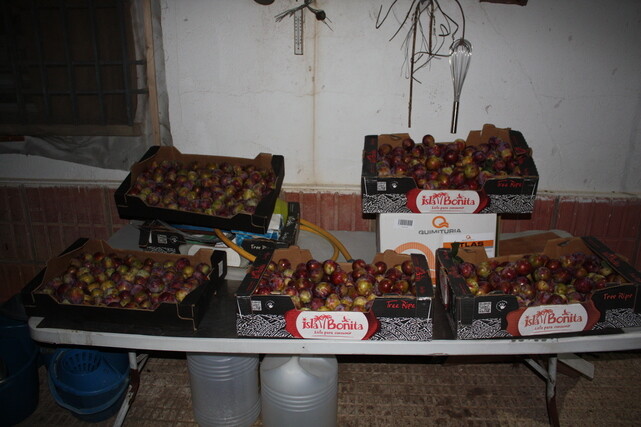
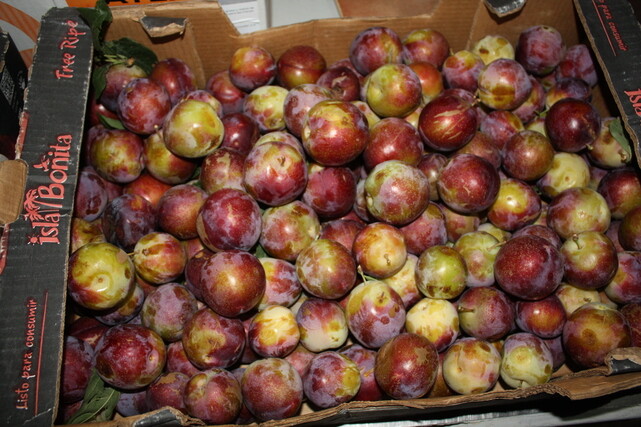
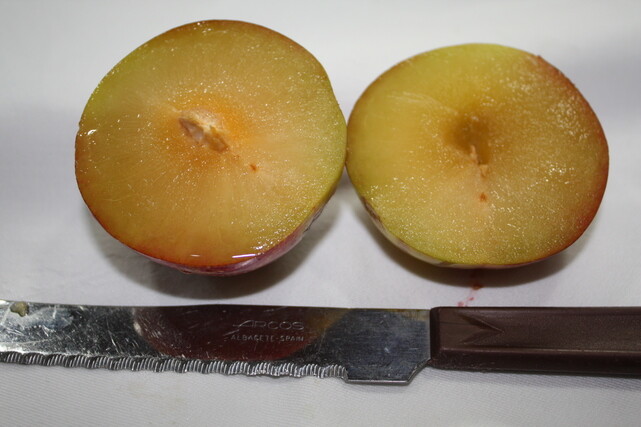
The belief that Japanese plums and pluots are not very productive or difficult to pollinate is absolutely a myth, only two things are necessary
1st- Being a crazy person like me hahahahahahahaha, and having a huge amount of varieties of pluots and Japanese plums in the same plot with which pollination is assured
2nd- To choose two or three good varieties of pollinating plums (even if they are not of good quality), to ensure the pollination of all varieties of Japanese plums, and pluots.
By the way and returning to the theme of the Spring Satin plumcot.
I use the quite ripe fruits to make Spring Satin Plumcot pie, and they are dense and delicious.
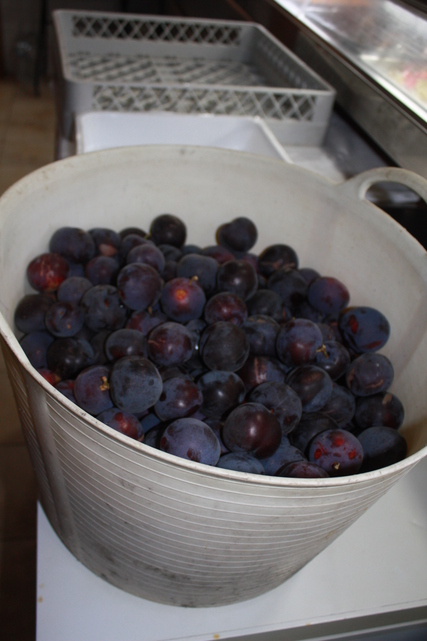
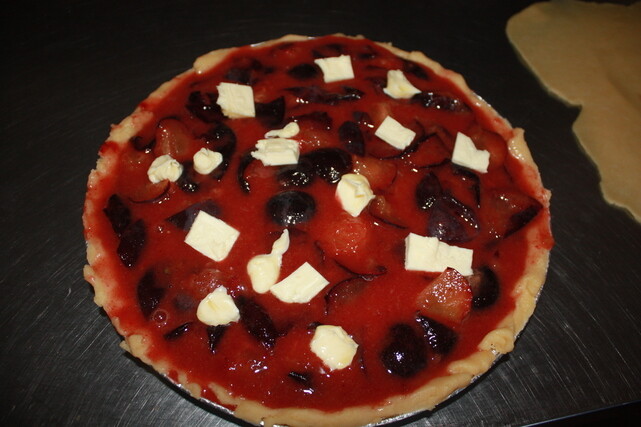
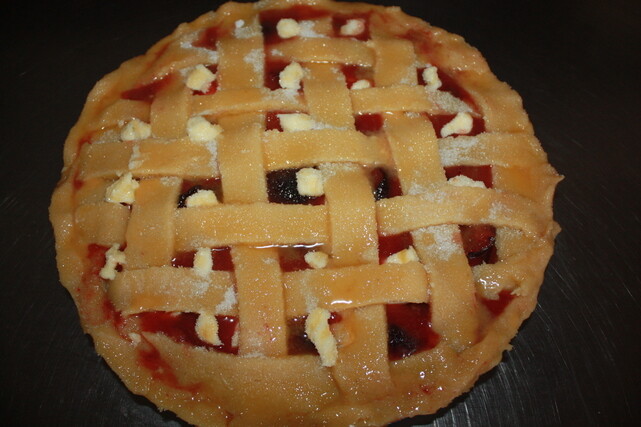
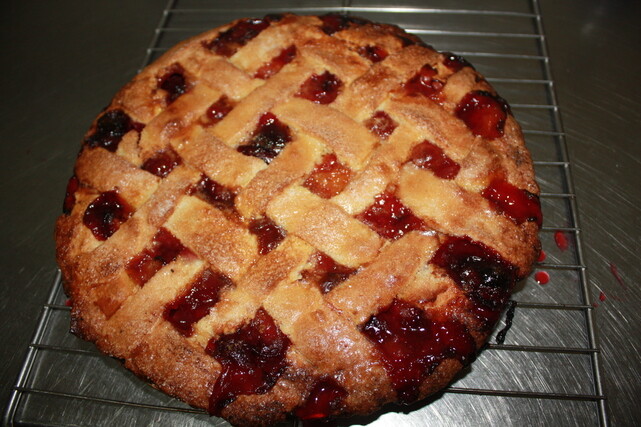
Regards
Jose
Thank you Jose, but I wasn’t asking about how to train plum trees, I am satisfied with my knowledge on that score. It just happens that I’ve found Elephant Heart to take longer to come into bearing than any other J. I grow. Most start fruiting by the 2nd year and are bearing significant crops by the 4th.
E. plum varieties often take a couple years more but if I’m in a hurry to taste a type of fruit I use festooning or pulling branches below horizontal to speed the process- or graft onto an already bearing tree.
I spend 7 months of the year, every working day pruning fruit trees and have been for 25 years now, along with having a small nursery with hundreds of trees to raise to bearing age. And I’ve been caring for fruit trees for a living for 55 years of my life.
Your experience probably doesn’t include inevitable frosts during and immediately after bloom time. J. plums can open up here in early to mid-April and we commonly get our last frost sometime in May- too often frosts well below freezing. Last year we had snow on Mother’s day (mid-May) and 24F temp the next night.
Cool weather also has a tremendous influence on whether our native pollinators are about. This year when earliest flowering J. plums and pluots were in peak bloom all of the pollinators were on sabbatical. In early spring they can be there one week and gone the next and then back the following.
Hi again Alan.
Wonderful if you have training pruning knowledge.
The trick of grafting on adult trees is very good to obtain a quick harvest and the consequent evaluation of the fruit (it is a very simple thing and I have never fallen into this detail).
Yes, the European plum varieties take a few more years to enter production, they are much slower.
Alan, curiously, the good varieties of European plum, which are varieties that I have very available (even the recent varieties that are wonderful), have always caught my attention less than the good varieties of Japanese plums (especially the red meat varieties), And for about three years I have been grafting good varieties of European plums, focusing on varieties of the “pruna” type, that is, those with an oval shape, and with a predilection for green, yellow and pink varieties before blue varieties.
Obviously you have to make exceptions with some blue plums like these:
https://artevos.de/sortenuebersicht/#Obstart_50
But yes, you are absolutely right, for example some European varieties that I have fruiting in my orchard are these:
- Coe’s Golden Drop
- President
- Stanley
- Valor
- Thames Cross
Etc…
And they take much longer than Japanese varieties to enter fruiting.
Why ?
I certainly don’t have a clear answer to this phenomenon.
I suppose it will have to do with their genetics, since most are varieties obtained from seed
Regards
Jose